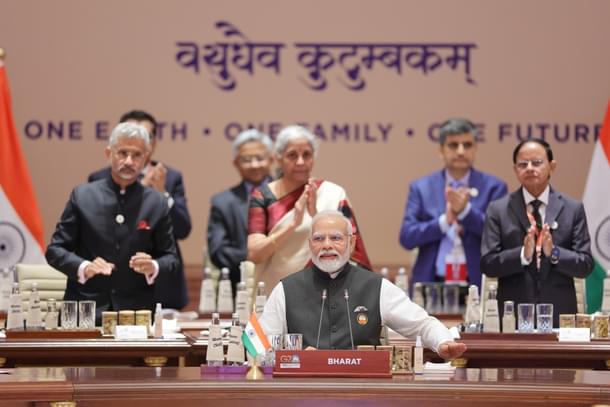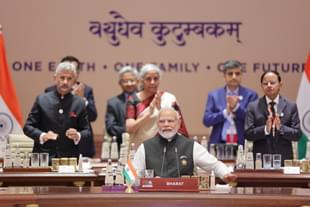World
G20's Next Big Challenge: Find A Solution To The Ballooning Global Debt Problem
Pratim Ranjan Bose
Sep 15, 2023, 06:30 PM | Updated 06:30 PM IST
Save & read from anywhere!
Bookmark stories for easy access on any device or the Swarajya app.


The resounding success of the G20 Summit in Delhi needs no introduction.
Preventing a division on 'Ukraine'; amplifying the voice of the global south; and putting economic agendas back in focus, are three key achievements during India’s presidency.
The world is now waiting for some solution to the global debt crisis. According to some estimates, nearly 60 per cent of the low-income countries were either in debt distress or at high risk.
Managing the crisis is crucial for G20 in achieving its wider goals. The much-talked-about reforms in multilateral development banks (MDBs) may help resolve part of the issues.
The special expert group headed by Lawerence H Summers and N K Singh submitted an initial report for MDB reforms in June. The final report is due next month when the presidency will be handed over to Brazil.
Political Goals
After the inclusion of the African Union, the forum now looks like a mini-United Nations (UN). Indeed, the G20 has taken up the task of implementing the nearly-forgotten 2030 UN agenda for sustainable development goals (SDG).
The writing on the wall is clear: A stronger G20 will push for reforms in the UN Security Council (UNSC) and trade regulations; bring greater focus to curbing money laundering and terror funding and; will pave the way for the development of the global south.
The political significance of the Delhi Declaration is not difficult to understand. The West is showing intent to give up part of its hegemonic control to prevent the rise of any rival power in the China-Russia axis.
The axis is not yet crystalised. The West and Russia see a future leader in India. But Beijing will surely not like the dilution of its clout. And, they do have serious clout built through finance.
The global tension was rising over the last decade as the Chinese moneybag started challenging the Western hegemony. As a permanent member of the UNSC, China had a political advantage. Money did the rest.
They dominated the world trade not only because they were the most efficient, but also because the World Trade Organisation (WTO) failed to check the huge subsidy flow and trade distortions.
The US initially underestimated China’s ambitions and, then retorted via tariff war which practically ended the free trade regime.
Hinrich Foundation reported over 176,000 trade distortions by China since 2008. The US comes next with 89,000 distortions. India is held for less than 20,000 distortions — less than Germany, Italy, France etc.
The Financial Mess
Trade regulation deserves attention. But, before that the world must find a solution to the debt crisis.
According to a December 2019 World Bank report, the global economy is witnessing the “largest, fastest, and most broad-based” debt surge in five decades. China’s chequebook diplomacy is responsible for creating a good part of the problem.
Finance was always a part of foreign policy and, loans were not always given on merit. That the International Monetary Fund-World Bank offered 22 or 23 bailouts to Pakistan in 75 years, is proof enough that the West used multilateral agencies for strategic gains.
But, China took the competition to unprecedented levels. From 49 per cent of gross domestic product (GDP) in 2011, Sri Lanka’s external debt reached 74 per cent of GDP in 2022. The majority of the growth was attributed to China.
Sri Lanka is no exception. From Zambia and Ethiopia to Maldives and Myanmar — the design is similar everywhere.
Smaller nations were offered endless loans, ignoring their repayment capacity. Money was blown into white elephant projects like the port city in Sri Lanka or the railroad to nowhere in Kenya.
The gains to Chinese corporates apart, easy money bought easy support to China across Asia and Africa. And, when nations became debt-strapped, Beijing demanded a piece of the Maldives or Sri Lanka for strategic use.
This was neo-colonialism.
Worse, it gave rise to an unholy competition. Sri Lanka sunk along with the money of every lender. Helping the nation to survive loan defaults might also mean bailing out a reckless lender, who is the prime cause of the problem.
The world, therefore, not only needs finance to save the collapsing economies. But also need a rule as to who would take how much haircut and why.
In 2010, Bangladesh received its largest credit line of $1 billion, from India. Over the next decade, India offered nearly $10 billion. MDBs offered more. China offered even more.
Infrastructure building cost in Bangladesh is arguably the highest in the world. It is anybody’s guess where a good part of the money is heading. The economy has developed early signs of distress. Who is responsible for this mess?
To cut the long story short debt crisis is not a single-dimensional story. Lenders blocked huge chunks of resources in unproductive assets. China is forced to stall many Belt and Road (BRI) projects.
That’s not all. Nations increased domestic public debt like never before. Corporations went on a spree to raise external borrowing. Much of the Chinese growth in the last decade was contributed by the property bubble built on borrowed finance.
The bubble is now bursting throwing the property sector in disarray. Municipal bodies, which fuelled the boom, are struggling under a huge debt pile amounting to 76 per cent of economic output in 2022.
China is not Ethiopia or Ghana. And, that’s the fear. If a large Chinese builder of the size of Evergrande fails to repay its loans, many banks in the developed world will be forced to pull down shutters.
Where Is The Money?
The problem, therefore, is much bigger and multi-dimensional than it appears. Mere supply-side management like relaxing the capital adequacy of MDBs and recapitalising them may solve only a part of the problem.
Even that wouldn’t be easy in the prevailing global environment. The developed world is not in a position where they were 20 or 30 years ago.
A strong German economy was the European Union’s best bet to survive the 2008 meltdown. Today, Germany is referred to as the sick man of Europe, if not a drag on the EU. The UK was and is struggling.
The rising global tension led to rising defence expenditure around the world. Europe and Japan which were traditionally living under the US protection have joined the arms race.
The US is better off but, only marginally. Demand is getting stronger in the US to reduce its defence budget. As for India, it needs money to fuel its ambition to be a developed economy and ensure security.
To sum up, the good days in global lending might have over. G20 may at best solve a part of the problem.





